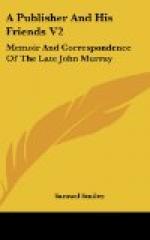The difficulty, however, was not yet over. While the principal editors of the Chaldee Manuscript had thus revealed themselves to the author of “Hypocrisy Unveiled,” the London publisher of Blackwood was, in November 1818, assailed by a biting pamphlet, entitled “A Letter to Mr. John Murray, of Albemarle Street, occasioned by his having undertaken the publication, in London, of Blackwood’s Magazine.” “The curse of his respectability,” he was told, had brought the letter upon him. “Your name stands among the very highest in the department of Literature which has fallen to your lot: the eminent persons who have confided in you, and the works you have given to the world, have conduced to your establishment in the public favour; while your liberality, your impartiality, and your private motives, bear testimony to the justice of your claims to that honourable distinction.”
Other criticisms of the same kind reached Mr. Murray’s ear. Moore, in his Diary (November 4, 1818), writes: “Received two most civil and anxious letters from the great ‘Bibliopola Tryphon’ Murray, expressing his regret at the article in Blackwood, and his resolution to give up all concern in it if it contained any more such personalities.” [Footnote: “Memoirs, Journal, and Correspondence of Thomas Moore,” ii. 210. By Lord John Russell.]
Finally the Hazlitt action was settled. Blackwood gave to Murray the following account of the matter:
December 16, 1818.
“I have had two letters from Mr. Patmore, informing me that Mr. Hazlitt was to drop the prosecution. His agent has since applied to mine offering to do this, if the expenses and a small sum for some charity were paid. My agent told him he would certainly advise any client of his to get out of court, but that he would never advise me to pay anything to be made a talk of, as a sum for a charity would be. He would advise me, he said, to pay the expenses, and a trifle to Hazlitt himself privately. Hazlitt’s agent agreed to this.” [Footnote: I have not been able to discover what sum, if any, was paid to Hazlitt privately.]
Notwithstanding promises of amendment, Murray still complained of the personalities, and of the way in which the magazine was edited. He also objected to the “echo of the Edinburgh Review’s abuse of Sharon Turner. It was sufficient to give pain to me, and to my most valued friend. There was another ungentlemanly and uncalled-for thrust at Thomas Moore. That just makes so many more enemies, unnecessarily; and you not only deprive me of the communications of my friends, but you positively provoke them to go over to your adversary.”
It seemed impossible to exercise any control over the editors, and Murray had no alternative left but to expostulate, and if his expostulations were unheeded, to retire from the magazine. The last course was that which he eventually decided to adopt, and the end of the partnership in Blackwood’s Magazine, which had long been anticipated, at length arrived. Murray’s name appeared for the last time on No. 22, for January 1819; the following number bore no London publisher’s name; but on the number for March the names of T. Cadell and W. Davies were advertised as the London agents for the magazine.




